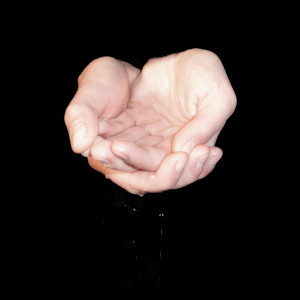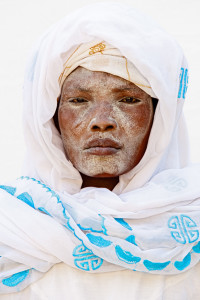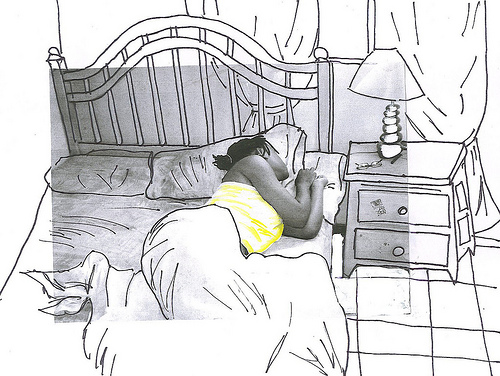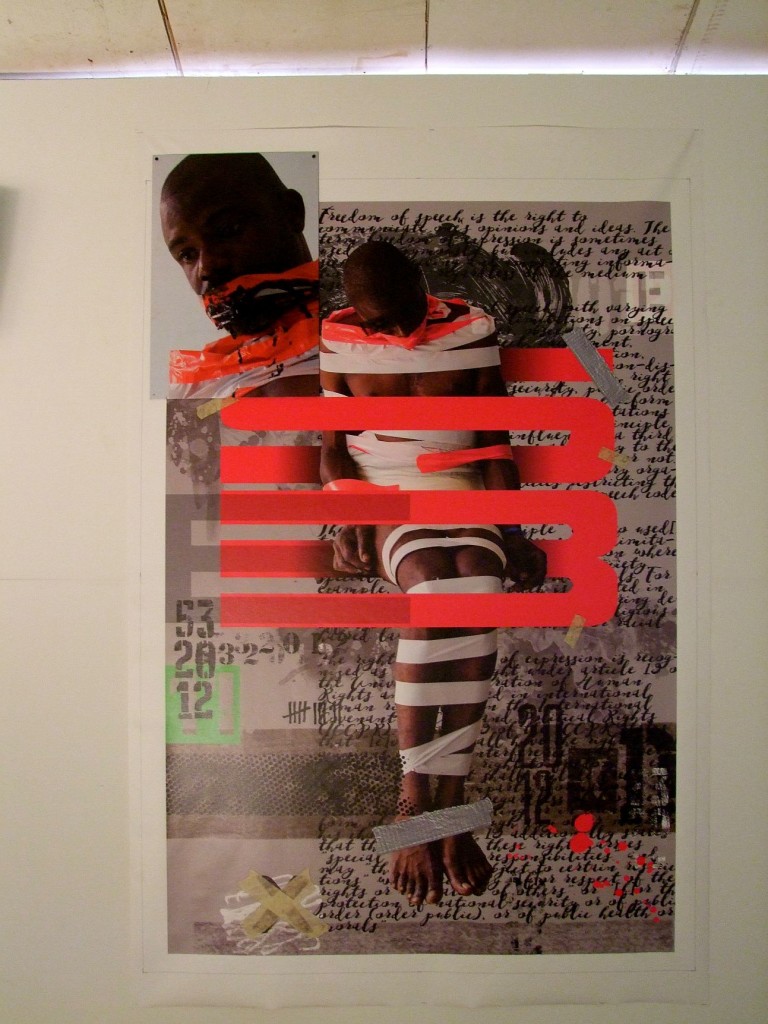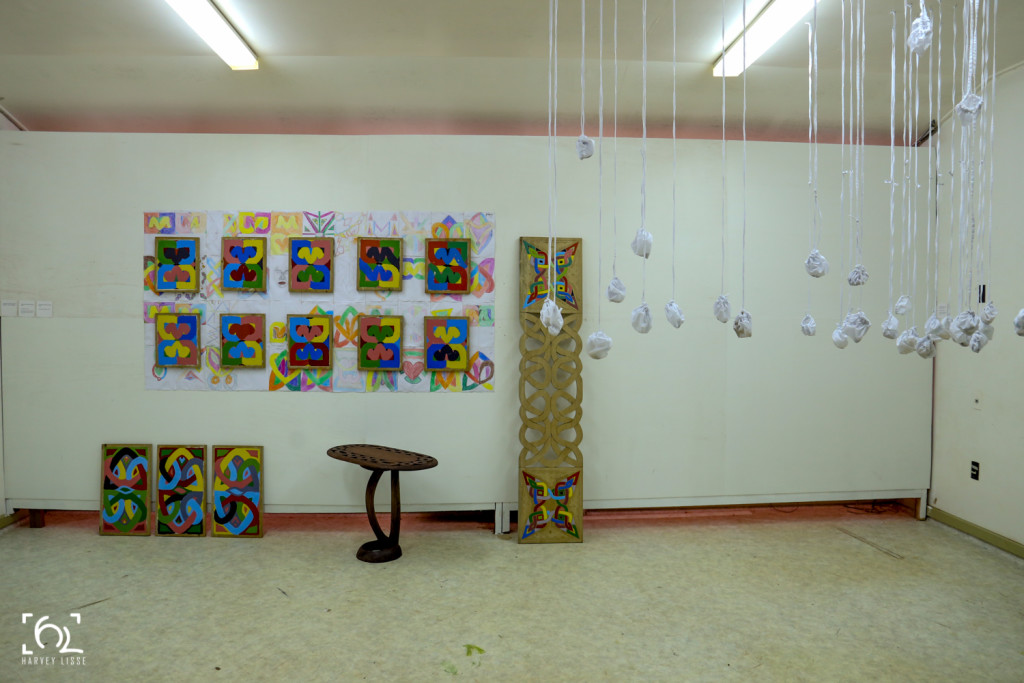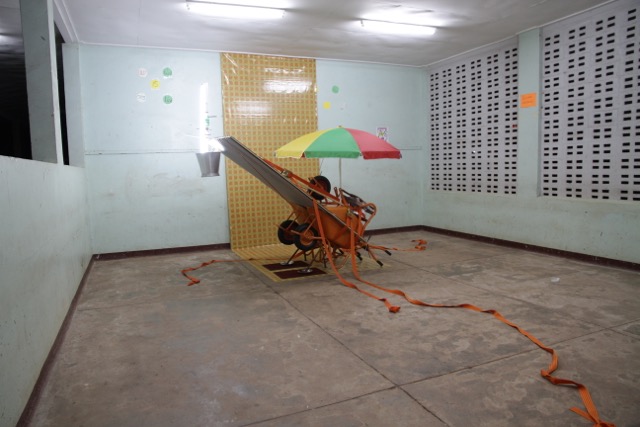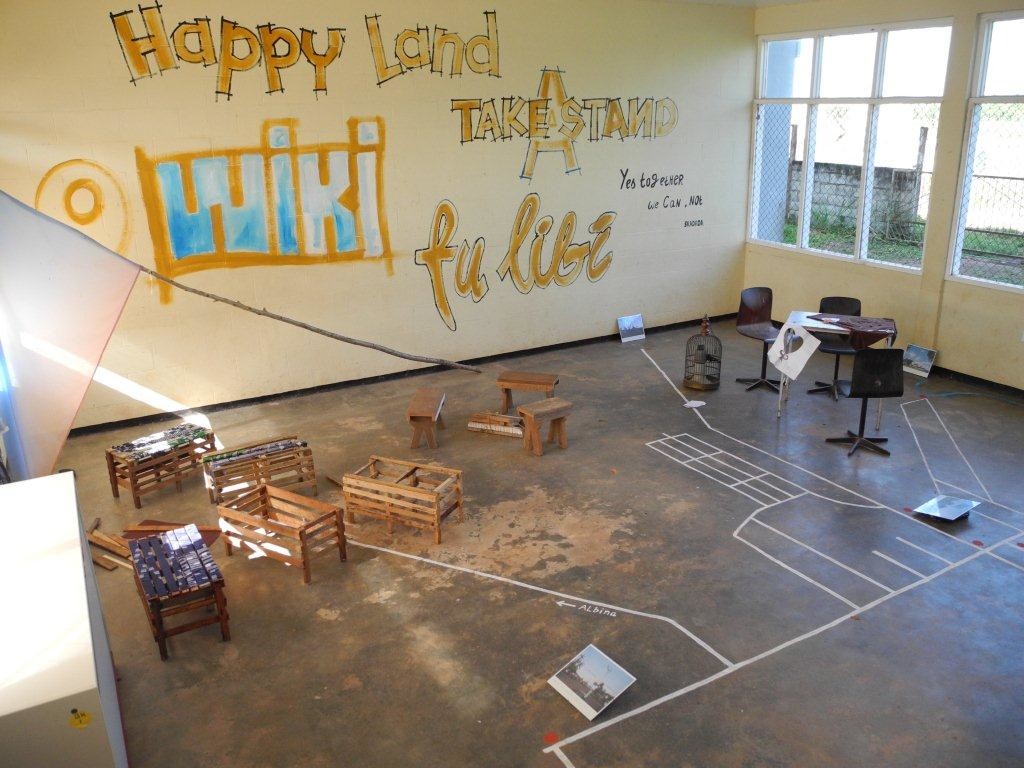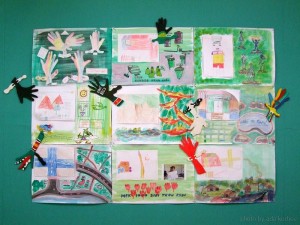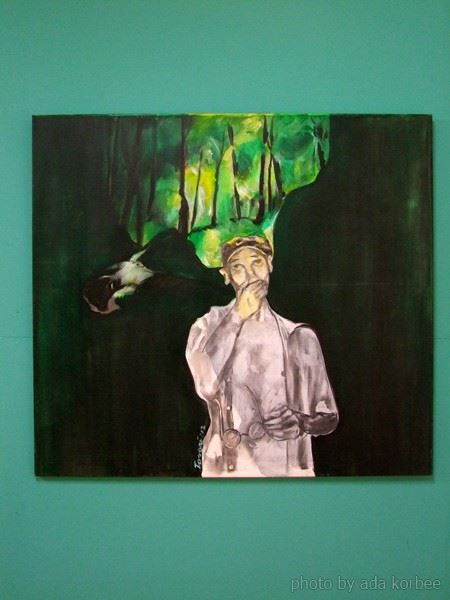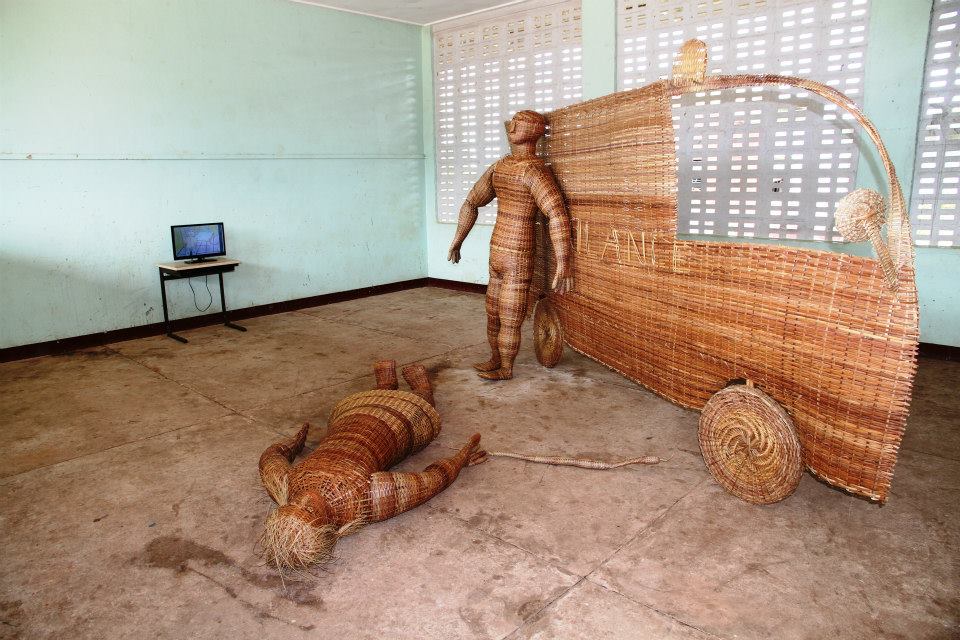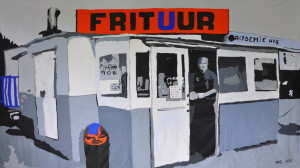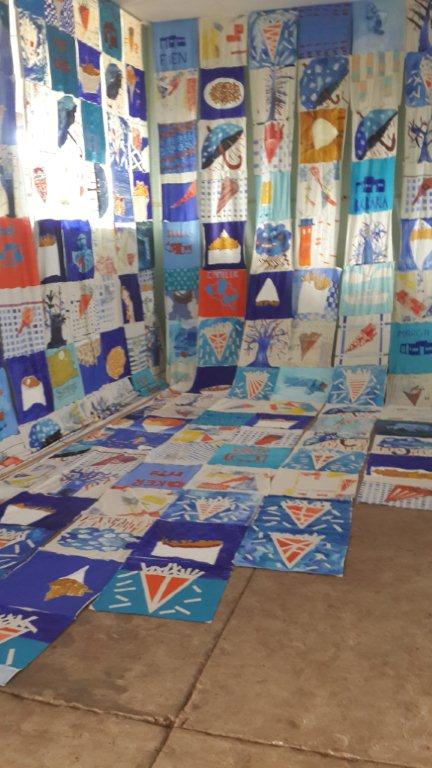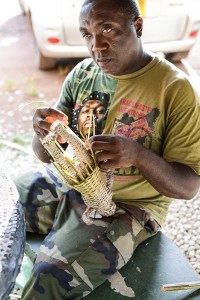
The exhibition, with all its art works, in and outside of buildings, and all that may or may not be art but is something which has been a consequence of ‘Tembe fu libi’, this all has become almost like a living, expanding, dynamic thing. ART with capital letters asks questions, ART provokes thoughts and discussions. This is exactly what is happening in Moengo. And because of the Moengo art exhibition, these discussions are also taking place elsewhere in the country.
Chandra van Binnendijk and Marieke Visser on the exhibition ‘Tembe fu libi’ in Moengo, Suriname.
Moengo Festival of Visual Arts
‘Tembe fu libi’: Art for living
Promoted as ‘the largest art exhibition’ ever held in Suriname, the Moengo Festival of Visual Arts 2015 ‘Tembe fu libi’ has a lot to live up to. And while it may not be the largest – ‘Twenty years of visual art in Suriname, 1975-1995’, in the Surinamese Museum from November 1995-January 1996, had a higher number of art works – it certainly is the most diverse contemporary art show ever held in Suriname. With ART in capital letters getting the floor as never before.

This diversity is visible in many different aspects. The list of participating artists shows birds of many feathers: they have joined ‘Tembe fu libi’ from all over the world – as well as from Moengo itself. The art works show the same versatility. Experimental video art, like Lode Demey’s ‘H2O Humanity’ can be seen in the same building as a more conventional wooden sculpture from David Linga ‘Fight for Freedom’. The work of school children from Suriname and Belgium has found a place in between the works of professional artists and highly qualified crafters, melting into these somewhat surreal surroundings of hospital rooms and school classes where time has gone by or stood still. Which of these is not always clear. In Moengo these days the streets have become canvasses, as have the walls. “C’est ci n’est pas une airco” is written on the wall of the church. The exhibition, with all its art works, in and outside of buildings, and all that may or may not be art but is something which has been a consequence of ‘Tembe fu libi’, this all has become almost like a living, expanding, dynamic thing. ART with capital letters asks questions, ART provokes thoughts and discussions. This is exactly what is happening in Moengo. (1) And because of the Moengo art exhibition, these discussions are also taking place elsewhere in the country.
Lode Demey, H2O, 2005.
‘Tembe fu Libi’ contains 78 works of art, created by almost 50 visual artists from all over the world, plus a local collective of street painters. Indeed a very mixed and international crowd is represented here, in this tiny village in eastern Suriname. They come from as close as the Caribbean region (Barbados, Curacao), and as far as Europe (Belgium, Kosovo), and the United States. This exceptional collection of art is brought together under the distinctive philosophy of artist Marcel Pinas, the motor behind the Moengo art movement. His points of departure for this exhibition were clear and nonnegotiable: every participant should be considered equally and presented as such, regardless of their background. Local and international artists, school children and crafters should all be matched with equivalence. This must have been quite a challenge for the two curators of ‘Tembe fu Libi’. In facing this test, art critic and writer Rob Perrée and artist Remy Jungerman also searched for different ways of presenting the art in the rather unusual spaces that were at their disposal for the design and the layout of the exhibition. And it should be noted: they really made the most of it. Every room was used to the best of its capacity, all art work and all participants were given sufficient space, and what is most important: the presentations expressed certain coherence. In spite of the wide variety of forms, shapes, media, and quality that the curators had to deal with, they managed to find interesting forms of presenting this diversity, through which the individual works of art, the playful children’s drawings, and the craft items seemed to back each other and created out of the ordinary contexts, thus providing the visitor with new and surprising ways of viewing and reflecting.
Dany Leriche and Jean Michel Fickinger, Divinités Noires.
One out of the series ‘Divinités Noires’.
The entrance to Venue 1, the former hospital which has been abandoned for many years now, is inviting. On the left wing of the hospital larger-than-life photographs of people of African descent, ‘Divinités Noires’, by Dani Leriche and Jean Michel Fickinger, seem to form a welcoming committee for the visitors of the exhibition ‘Tembe fu libi’.
Venue 2 and 3 are schools. The exhibition coincides with the summer holiday so the class rooms are available. The last official venue is the Contemporary Art Museum Moengo (CAMM). But, as stated before: ‘Tembe fu libi’ is everywhere.
To exhibit art in such a non-conventional location is a dare. Earlier this year the 2nd Kochi-Muziris Biennale ‘Whorled Explorations’ was held in Kerala, India. This Biennale has shown too that it can be inspiring and refreshing to work with what space is available. Sometimes you just work with what you have and make things happen: you make it work. This is proven possible in Kerala and now in Moengo too.
With such an abundance of art work at display, it is inevitable to make choices in what to include in the review of this energetic exhibition. We have selected twelve paintings, installations, videos or other forms of presentation which we find striking expressions of what the entire exhibition contains and what it stands for. Those who would like to read and see more are advised to search for the bilingual catalogue (in English and in Dutch) with the same title.(2)
Ravi Rajcoomar, two paintings from the series ‘Save the children’
From the Series Save the Children, 2015.
Two large canvasses, in black, grey and white with patches of bright red. Kind of alarming. Is it blood? The paintings are covered with an unintelligible script, some of which reminds of newspaper print. Just when you think you can read a word, it takes off in a different direction. SUPE never becomes SUPER. Ravi Rajcoomar is also a graphic designer and his fascination for scripts and fonts is a familiar aspect in his work. In a way the wall-covering works could be interpreted as a traffic situation seen from above, a map of busy streets with red lights and many crossroads. In that regard they correspond very well with Sheena Rose’s work on paper, hung in the same room, which is also about street views and town traffic, in this case inspired by her residency in Moengo.
Sheena Rose, video animation
Town, animation, 2009.
The animated drawn lines by Barbadian Sheena Rose are projected on a TV screen. The images show life on the busy streets of cities. Sidewalks, shops, passersby, houses, squares … They all dance by, swinging as if they have a life of their own, vivid and spirited.
Echo, ‘Het elfde gebod’ [The eleventh commandment]
Het Elfde Gebod, 2015.
A derelict room without windows, slightly claustrophobic, the air almost heavy with sadness. And at the same time a strange atmosphere of serenity. Several elements form an installation titled ‘Het elfde gebod’ [The eleventh commandment]. “Thou shall not be free.” One wall is covered with plaster masks of a face, the same face for every mask, with closed eyes. On another wall a large photo of a man, bound and gagged. Bound literally with tape, but also by a photo-shopped banner. His posture reminds of images of Jesus Christ on the cross. His stare is blank. One wall is bare except for a broken fixture that was already there. And, propped against the last wall is a cupboard. From one of the opened doors protrudes a torso and between the spread legs and inside the open womb is the same head as that of which the plaster masks were made. The birth of a silent head. On the bottom part of the cupboard a sign from decades ago says: “Sanity storage, not in use”. Sanity seems very far away indeed, in this creation of the spontaneously established collective of likeminded spirits: Echo.
Razia Barsatie & Lolita Bron, ‘Zelfstandigheid’ [Independence]
Dona Sr. and Dona Jr. (left), Razia Barsati and Lolita Bron, Zelfstandigheid (right), 2015.
A fragrant installation, made up of aromatic herb sachets. The white cotton sachets, made by pangi-seamstress Lolita Bron, are filled with sweet smelling herbs, and hang from the ceiling at nose level. Barsatie is an artist who loves to play with the senses, and dares to take possession of the public space. Her installation is one of a kind; although a very simple, almost childlike display, it is a unique element in the Moengo exhibition, underscoring the wide diversity of this show.
Sra Stre Art C (SR), ‘Wake up and live’
 Wake up and live, 2015.
Wake up and live, 2015.
Outside of Venue 1, near one of the larger Chinese shops, is a group of ghostlike figures, an art work by Hesdy Mertowirijo, Kurt Nahar and André Sontosoemarto. These ‘ghosts’, made from chicken fence covered by cemented fabric, are standing, sitting and gesturing in different ways. There is a sign that reads: “Moengo wake up and live”, and that is what the artists seem to ask from the people in Moengo, or more in general, from the person who is looking at this work. Are you really awake? Are your really living?
Some people were afraid of this collective art work and questioned whether it should stay. In a way, because of this discussion triggered by ‘Wake up and live’; it is already doing what it was put there for in the first place: waking people up.
Tirzo Martha, ‘Ex Surinamer’
Ex-Surinamer, 2015.
Ex-Surinamer (detail), 2015.
The installation ‘Ex Surinamer’ by Tirzo Martha is on display by itself in one class room. On first sight it is a combination of a lot of random objects. The several parts, for example a wheelbarrow, a comb, several meters of orange lint, small bottles with Alcolade, rum and Florida water, are all brand-new. All pieces are familiar in a Surinamese cultural setting. But only an ‘Ex Surinamer’ would publicly display these objects that were once part of his identity in the form of an altar, like a feast for the eye. Is it a coincidence that a beautiful poem by Trefossa, one of Suriname’s most beloved poets, is still visible on the blackboard? Lines written in chalk, almost erased …
Bart Stuart & Klaar van der Lippe, ‘Maar de Lucht is van Iedereen’ [But the Sky Belongs to Everbody]
Happyland, 2015. Wall text Kurt Nahar.
A class room on the first floor of the St. Theresia School is the location of the installation ‘But the Sky Belongs to Everybody’, by Stuart and Van der Lippe. Together with Kurt Nahar this artist duo have taken a closer look at Moengo’s past and how that history as a company town reflects in the town it has become today. The different elements that form the installation may not be ‘understandable’ for all visitors but everybody will be familiar with something. Either the typical Maroon benches, decorated with pangi-fabric, complete with a poetic instruction on the chalk board how to make one. Or the Sankofa-emblem, a well-known African symbol, used for grave markers on the graves of Surinamese descendents of enslaved forefathers. Sankofa means: look back and keep all that’s good.
On the floor of the class room a map is painted, of Moengo, a few decades ago. On the other side of the river: Happyland. This name rings a bell for art lovers who know Moengo: Remy Jungerman has named his giant toads at the entrance of the town ‘Return to Apuku Happyland’. It is a place with a not well-known and not so very happy history.
In the center of Moengo a wall painting by Stuart and Van der Lippe. also tells about Moengo’s history, and also throughout Moengo: sky-blue flags on high poles.
This way of presenting the viewer with seemingly unrelated tableaus is the way Bart & Klaar work, rather presenting ideas than objects. Kurt Nahar’s surrealistic wall statements melt easily into the full ‘picture’.
Charl Landvreugd, ‘Movt nr. 8: Robby’
Movt nr.8 : Robby, 2015.
Detail Movt nr. 8: Robby.
A series of photographs and one mirror form the contribution of Charl Landvreugd to ‘Tembe fu libi’. From left to right the images become more abstract, blurry even. In the first picture one can see the artist himself, standing still in an open space, the opening to the outside almost inviting but also half closed by a gate. The picture next to this one is rotated 90 degrees. It shows a man lying on an uncomfortable outdoors bench. Beneath that picture is one of a vase and a chandelier, upside-down. The story these pictures are telling is getting stranger, more incomprehensible and also: more detached. Maybe this story doesn’t need to be understood. In the middle is a mirror but it hangs too high to even reflect on one’s one reflection.
Next to Charl Landvreugd’s photo installation is an untitled, recent, work by Sunil Puljhun. This artist is much more direct in his story, no ambiguity at all in his version of the daily newspaper which forms the center of this work: The Bad Times. Headlines tell about 80,000 people from Congo who have fled. Again a strong combination of work in one room.
René Tosari & the students of the Tembe Art Studio
Rene Tosari with students Tembe Art Studio, 2015.
Selfportrait, 2013.
The only room that got a real makeover – the walls have been painted green –, is the room where René Tosari’s work is combined with a collage-style centerpiece with some random milestones from Suriname’s history depicted on separate works, some in the form of a hand. This group work was made by the artist and the children who visited the Tembe Art Studio during Tosari’s residency in Moengo. The artist’s own work is placed left and right of the collective work. The green wall creates a strong sense of connection. Green is the color of hope, of growth, of health. And these words are reflected in the art on the walls of this space, it is what the artist and his helpers project for Moengo’s future. And in this space, one can see it is possible.
Razia Barsatie + Rudi Pinas, ‘Het kostgrondje’ [The vegetable garden]
Het Kostgrondje, 2015.
It looks like a three-dimensional illustration that is brought to life, but it remains a still-life, this life-size scene made up of wickerwork characters. We see a woman lying on the ground, a snake next to her, a man standing by and the side of a vehicle with the word ‘ambulance’ woven on the surface. Walking around it, or even through it (the ambulance is very inviting to step into it and peep outside the window from behind the wheel) the atmosphere resembles one we can find in a playground. The installation is designed by Razia Barsatie, a representation of a scene from a series of animations Barsatie had made with children. The actual wickerwork was done by a skilled crafter. It is this kind of cooperation between visual artists and crafters which makes the ‘Tembe fu Libi’ such a special kind of exhibition.
Lode Demey & Elke D’Haenen, ‘Baraque Friture Project’ [The French Fries Project]
Baraque Friture, 2015 (in cooperation with students of Westhoek Academy, Koksij, Belgium).
Installation Baraque Friture Project students Westhoek Academy, Koksij, Belgium, 2015.
Series of simple paintings of similar size attached to each other, forming long drapes in bright colors with mostly orange and different hues of blue. Festive, one is inclined to think when walking into the classroom where these drawings are hung from the ceiling, along the wall and flowing over on the floor. But let’s not be fooled by the first impression. The cheerful drapes carry a message; they depict a serious warning because a part of the cultural heritage of Belgium is vanishing: the traditional fish & chips stands in Flanders. All paintings show something related to the famous Belgian French fries, whether it is a plate filled with the dish, a person putting it in his mouth, a cone full of fries, fries raining down on an umbrella … Art is used here to call attention to the phenomena of globalization, and its danger to the survival of unique local habits and forms. The two artists worked here with schoolchildren and students of an art academy.
Jakup Ferri – ‘Muscle Memory’
Muscle Memory, 2015.
‘Muscle Memory’ consists of four separate wall hangings which have been carelessly connected to each other with strings. They hang almost sloppily on a piece of cord, in the middle of a well-used class room, forming an odd display of tapestry. But then again they are also not so odd after all, probably because of their fleeting similarity with the traditional Maroon cloths, the pangi which can be seen worn by many women in Moengo, and also a part of this exhibition. The images on the colorful textile works of Jakup Ferri look close to home at first sight – two swimmers, a football player, a man and a woman facing each other, a group of smiling animals. Bright colors, applied with course stitches of woolen threads. But a closer look brings details to the forefront – do animals really smile? What extremely long legs the football player has! What kind of liquid is that cherub pouring for the cute couple? Ferri’s textile works have indeed been described as depicting circumstances in which people are alienated from their surroundings. But in a strange way this is exactly the reason why they seem to fit effortless in the background of this old classroom of a school in Moengo, far away from where they originated.
Catalogus Tembe fu libi, 2015.
Art critic Rob Perrée once stated that Marcel Pinas, who is the driving force behind this exhibition, not only has an impressive oeuvre of art work, but that the town in whose revival Pinas puts so much energy, is perhaps Pinas’ greatest installation of all. This statement springs to mind when reflecting on all that a visitor of ‘Tembe fu libi’ has seen after an entire day of strolling, looking, experiencing, listening and even smelling … Because all senses are involved and ART pops up in unexpected places in every part of the town one tends to give more meaning to everything. Even a normal street sign seems to have more significance. And that is what ART does: it lets you think, it lets your mind run faster. Not only about the art objects itself, but about the themes they touch on, and about life itself. And, good ART makes life LIFE, with capital letters. Na so a de. And so it is.

